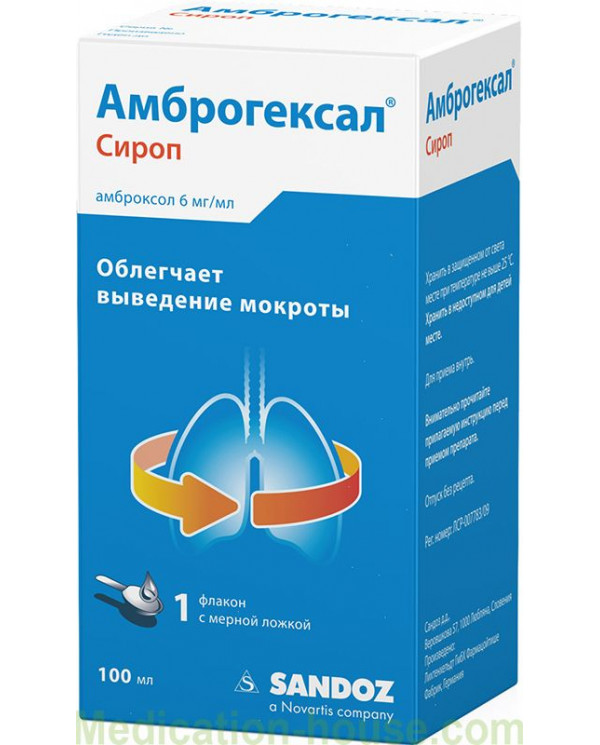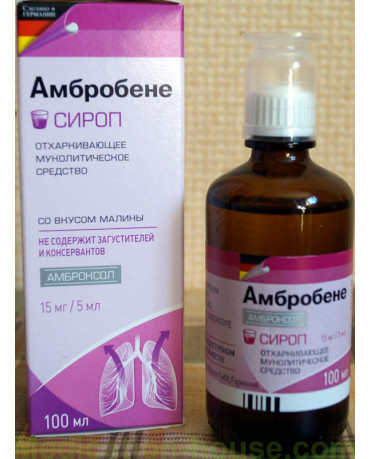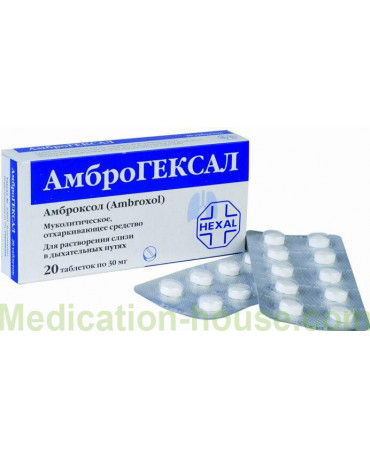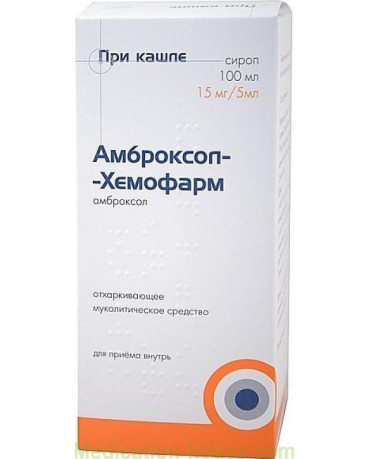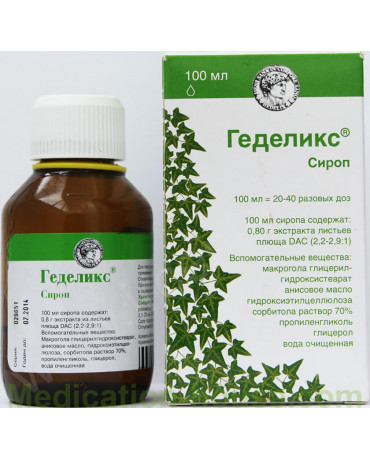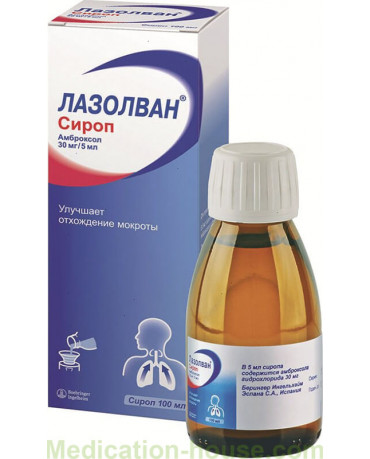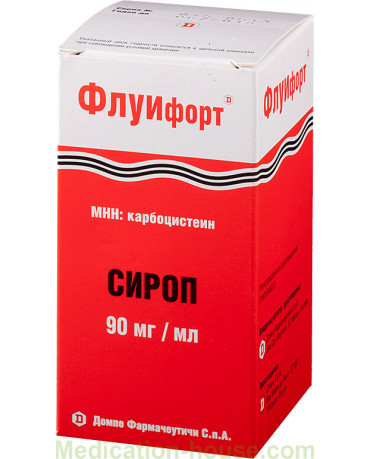Ambrohexal syrup instruction
You can buy Ambrohexal syrup here
pharmachologic effect
Mucolytic drug with an expectorant effect. It has a secretomotor, secretolytic and expectorant effect. It stimulates the serous cells of the bronchial mucosa, increases the content of the mucous secretion and the release of the surface-active substance (surfactant) in the alveoli and bronchi, normalizes the disturbed ratio of the serous and mucous components of sputum.
By activating hydrolyzing enzymes and enhancing the release of lysosomes from Clara cells, ambroxol reduces the viscosity of sputum. Increases motor activity of ciliated epithelium, increases mucociliary transport, facilitates the removal of sputum from the respiratory tract.
When taking Ambroxol inside, the effect, on average, occurs after 30 minutes and lasts 6-12 hours, depending on the size of a single dose.
Pharmacokinetics
Suction
After oral administration, Ambroxol is rapidly and almost completely absorbed. Tmax is 1-3 hours.
Distribution
Plasma protein binding is approximately 85%. Ambroxol crosses the placental barrier, excreted in breast milk.
Metabolism
It is metabolized in the liver with the formation of metabolites (dibromanthranilic acid, glucuronic conjugates), which are excreted by the kidneys.
Breeding
It is excreted mainly by the kidneys - 90% in the form of metabolites, less than 10% unchanged. T1 / 2 from plasma is 7-12 hours. T1 / 2 of Ambroxol and its metabolites is approximately 22 hours.
Pharmacokinetics in special clinical cases
Due to the high binding to proteins and large Vd, as well as the slow backward penetration from tissues into the blood, during dialysis or forced diuresis, substantial excretion of ambroxol does not occur.
Ambroxol clearance in patients with severe liver failure is reduced by 20-40%.
In severe renal failure, T1 / 2 of Ambroxol metabolites increases.
Indications
Acute and chronic diseases of the respiratory tract with the release of viscous sputum:
- acute and chronic bronchitis;
- pneumonia;
- COPD;
- bronchial asthma with difficulty in sputum discharge;
- bronchiectatic disease;
- treatment and prevention of respiratory distress syndrome (for syrup 3 mg / ml and solution for oral administration and inhalation).
Contraindications
- I trimester of pregnancy;
- lactation (breastfeeding);
- children's age up to 6 years (for tablets);
- Lactase deficiency, lactose intolerance, glucose-galactose malabsorption (for tablets);
- hereditary fructose intolerance (for syrup);
- Hypersensitivity to ambroxol and other components of the drug dosage forms.
With caution, Ambrohexal syrup should be used for peptic ulcer of the stomach and duodenum (due to a possible exacerbation), renal failure, liver failure, in the II and III trimesters of pregnancy.
Side effects of Ambrohexal syrup
Classification of unwanted effects according to the frequency of their development (WHO): very often (≥1 / 10), often (from ≥1 / 100 to <1/10), infrequently (from ≥1 / 1000 to <1/100), rarely (from ≥1 / 10,000 to <1/1000), very rarely (<1/10 000), the frequency is unknown - according to the available data, it was not possible to establish the frequency of occurrence.
Allergic reactions: rarely - skin rash, urticaria; frequency unknown - anaphylactic reactions, including anaphylactic shock, angioedema, pruritus, and other hypersensitivity reactions. For syrup, 6 mg / ml additionally: rarely - exanthema, facial swelling, shortness of breath, itching, fever; very rarely - angioedema; frequency unknown - allergic contact dermatitis.
From the digestive system: often - nausea; infrequently - vomiting, diarrhea, dyspepsia, abdominal pain. For syrup 3 mg / ml additionally: infrequently - heartburn. For syrup, 6 mg / ml: often - oral and pharyngeal hypesthesia; infrequently - with prolonged use in high doses - gastralgia, nausea, vomiting; rarely diarrhea.
From the nervous system: often - a change in taste.
From the skin: for syrup 6 mg / ml: very rarely - severe skin reactions (epidermal necrolysis, Stevens-Johnson syndrome).
Other: often - decreased sensitivity in the oral cavity or pharynx; infrequently - dry mouth; frequency unknown - dry mucous membranes of the respiratory tract. For syrup, 6 mg / ml: rarely - dry mouth and respiratory tract, rhinorrhea, dysuria, weakness, headache.
Overdose
Symptoms: nausea, vomiting, diarrhea, gastralgia, dyspepsia, increased salivation (syrup 6 mg / ml).
Treatment: cancel the drug, induce artificial vomiting, gastric lavage during the first 1-2 hours after taking the drug; intake of fat-containing foods; symptomatic therapy.
special instructions
Ambroxol should not be taken simultaneously with antitussive drugs that can inhibit the cough reflex, for example, with codeine, because this may make it difficult to remove liquefied sputum from the bronchi.
Ambroxol should be used with caution in patients with a weakened cough reflex or impaired mucociliary transport due to the possibility of sputum accumulation.
Patients taking Ambroxol are not recommended to perform respiratory gymnastics due to difficulty in sputum discharge. In patients in serious condition, liquefied sputum aspiration should be performed.
Ambroxol should not be taken immediately before bedtime.
In patients with bronchial asthma, ambroxol may increase coughing.
In patients with severe skin lesions - Stevens-Johnson syndrome or toxic epidermal necrolysis - an influenza-like condition can be observed in the early phase: temperature, body aches, rhinitis, cough, pharyngitis. With symptomatic therapy, an erroneous prescription of mucolytic agents, such as ambroxol hydrochloride, is possible.
There are isolated reports of the detection of Stevens-Johnson syndrome and toxic epidermal necrolysis, coinciding in time with the appointment of the drug. However, there is no causal relationship with the drug.
With the development of the above syndromes, it is recommended to stop taking the drug; the patient should consult a doctor immediately.
The solution for oral administration and inhalation contains sodium metabisulfite (preservative), which can cause the development of hypersensitivity reactions (especially in patients with bronchial asthma), which manifests itself in the form of vomiting, diarrhea, bronchospasm attacks, impaired consciousness or anaphylactic shock. These reactions can occur very individually, as well as lead to life-threatening consequences.
For syrup, 6 mg / ml additionally: in case of impaired bronchial motility and an increase in the amount of secretion (for example, motionless cilia syndrome), because of the danger of mucus accumulation, the drug can be taken only after consultation with your doctor and with medical supervision. In severe renal and hepatic impairment, it is necessary to use lower concentrations, or to increase the interval between doses of the drug.
Indication for patients with diabetes mellitus: 1 tablet contains less than 0.01 XE; 1 scoop (5 ml) of 3 mg / ml syrup contains 1.75 g of sorbitol (less than 0.15 XE); 1 scoop (5 ml) of 6 mg / ml syrup contains 2.525 g of sorbitol (0.21 XE).
With renal failure
With caution, the drug should be used in case of renal failure.
In severe renal impairment, lower concentrations should be used, or the interval between doses should be increased.
With impaired liver function
Caution should be used in liver failure.
In severe liver dysfunction, lower concentrations should be used, or the interval between doses of the drug should be increased.
Pregnancy and lactation
Ambrohexal syrup is contraindicated for use in the first trimester of pregnancy.
The use of the drug in the II and III trimesters of pregnancy is possible only if the intended benefit to the mother outweighs the potential risk to the fetus.
Ambroxol crosses the placental barrier. In experimental animal studies, it has been shown that the drug does not affect embryrofetal development, childbirth and postnatal development.
Ambroxol in small quantities is excreted in breast milk, therefore, when using syrup Ambrohexal, it is necessary to decide on the termination of breastfeeding.
Drug interaction
With the simultaneous use of syrup Ambrohexal with antitussive agents (including with codeine), there is difficulty in sputum discharge due to a decrease in cough.
Ambrohexal syrup increases the penetration into the bronchial secretion of amoxicillin, cefuroxime, doxycycline, erythromycin.
Mode of application
During treatment with Ambrohexal syrup, it is necessary to consume a lot of fluids (juices, tea, water) to enhance the mucolytic effect of the drug.
The duration of treatment with Ambrohexal is determined by the doctor individually and depends on the severity of the disease. If it is necessary to use the drug for more than 4-5 days, a doctor's consultation is required.
Syrup 3 mg / 1 ml
The drug should be taken orally after a meal. 1 scoop of Ambrohexal syrup (5 ml) contains 15 mg of Ambroxol hydrochloride.
Adults and children over the age of 12 years are prescribed 2 scoops 2-3 times / day (60-90 mg / day) in the first 2-3 days, then 2 scoops 2 times / day (60 mg / day). In severe cases of the disease, the dose is not reduced during the entire course of treatment. The maximum dose is 4 measured spoons (60 mg) 2 times / day (120 mg / day).
Children aged 5 to 12 years are prescribed 1 scoop 2-3 times / day (30-45 mg / day).
Children aged 2 to 5 years are prescribed 1/2 scoop 3 times / day (22.5 mg / day).
Children under 2 years of age are prescribed 1/2 scoop after 2 times / day (15 mg / day). The drug is prescribed only under the supervision of a doctor.
Syrup 6 mg / 1 ml
The drug should be taken orally.
Adults and children over the age of 12 are prescribed 1 scoop (5 ml) 3 times / day for the first 2-3 days, then 1 scoop (5 ml) 2 times / day.
Children aged 6 to 12 years are prescribed 1/2 scoop (2.5 ml) 2-3 times / day.
Children aged 2 to 6 years are prescribed 1/4 scoop (1.25 ml) 3 times / day.
Children under 2 years: 1/4 scoop (1.25 ml) 2 times / day. The drug is prescribed only under the supervision of a doctor.
Storage conditions and shelf life
Ambrohexal in the form of a syrup should be stored out of the reach of children, protected from light at a temperature of no higher than 25 ° C. Shelf life is 2 years.
Terms of sell
You can buy Ambrohexal syrup without a prescription.

